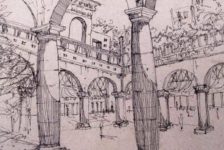After the success of his last article “10 Ways Design Students Fail Projects and How to Avoid Them” designer and lecturer Barry Lupton joins us again at Landscape Architects Network to give us his thoughts as to what qualities a great designer possesses:
Designers are complex beings occupying an increasingly complex domain. The skills, traits and characteristics which define the greatest designers are equally complex. To provide some insight, I’ve undertaken some reflective analysis of my own skills, traits and characteristics. I then used a useful antonym website to compile the list below.
1. Sorry, come again?

Good communication skills are vital to the design process; image credit: Monkey Business Image/shutterstock
Verbal communication is both a science and an art, and great designers can usually orate and articulate with the best of them. Designers must be adept at reading an audience and adjusting to suit, being succinct, engaging, passionate without being frightening, and most of all, they must be clear.
But don’t worry, if you eh, um, ah, uh, like…the ability to communicate can be learned. If you want to write well, read; if you want to communicate well, listen and speak to the right people.
2. Thick skin
Let’s face it, if you’re not prepared to have your wonderful ideas sneered at, torn to shreds, violated, stolen, compromised and generally beaten into submission, you should really think about becoming a tortured artist. All good designers need to have a very thick skin. They will usually have a callused tongue from biting it in meetings.
On the positive side, the terrible things done to ideas are these days typically referred to as collaboration; and everyone loves collaboration, right?
3. Knowing when to bang your fist
Real change is only brought about by the conviction, stubbornness and perseverance of groups and individuals. More often than not, it’s the work of the latter. Although designers must have a thick skin, great designers also have unwavering commitment, passion and belief in what they are doing. Great designers also recognise when it’s right to bite their tongue or bang their fist.
Don’t believe in what you’re doing? Then stop doing it.
4. Job juggling
The best designers can transfer their skills to any task and juggle a multitude of activities at any one time. In fact, one of the benefits of quality design training is the knowledge and ability to take anything on.
A great designer will never be out of work.
5. In weakness there is strength
The designer skillset touches domains from psychology to soil amelioration, and it’s impossible to be an expert in everything. The best designers know, and are comfortable with their strengths and weaknesses. They embrace both and are not afraid to draw in advice and support from those more able.
If you lack brilliance, seek it in others.
6. Mind your see-saw
The great designer’s mind is akin to a seesaw. On one side sits an artist, on the other, an engineer. The designer sits in the middle, balancing the demands of what the artist saw and what the engineer sees. Great designers and great designs, reconcile these perceived opponents, and do so effortlessly.
If you find yourself saying things like…”I hate all that emotive, conceptual stuff” or, “I’m not one for detail drawings”, you are probably veering too far on one side of the design see-saw.
7. The knowledge between a rock and a soft place There is no escaping it, great landscape architects know and love plants. They also know hard materials inside and out, and understand the complex interface that exists between the two. It could be posited that a designer’s life centres around building knowledge of hard and soft stuff; and figuring new ways to mediate their relationship to satisfy client demands.
Want to be a great designer? Embrace your mediums of expression.

The Highline is a great example of merging both soft and hard materials to create a masterpiece; image credit Sean Pavone/shutterstock
8. Problem finders
You’ll often hear people saying that good designers are good problem solvers; this is certainly correct, but great designers are also brilliant problem finders. And I’m not referring to critics, they’re a different breed. Problem finders are those that recognise potential and opportunity where others see obstacles and reasons for not doing something. If you’re a great designer, you already do this every day, probably all day; in fact, you might well be consumed by it. Don’t worry, you’re not alone.

Having mulitple personalities can aid the design process; image credit: Straight 8 Photography/shutterstock
9. Split Personality
There is no one specific personality trait which lends itself to design brilliance. Certain traits, like extroversion and openness, can aid imagination and support team working abilities. Conscientiousness on the other hand, can feed a designer’s capacity to experience empathy; an important factor in all aspects of design. It also lends itself to managing one’s own time.
While there is no one personality trait, many designers are naturally reflective. Others, often as a response to the fuzziness of design training, learn to develop reflective skills. They learn one of the most important design skills required for brilliance: to question oneself.
10. Beware of wariness
The most important characteristic of a great designer is awareness. Some designers are simply born aware. Others, through training and experience, have their senses heightened and they become alert. The world becomes alive, exciting, stimulating and even the most banal becomes a source of inspiration to be explored, saved, and reinterpreted. Awareness drives the design mind.
If this doesn’t resonate with your core, you aren’t doing it right.
Don’t worry if none of the above resonates with you. You can always do what the vast majority of designers do until they’re recognised for their brilliance: work damn hard, grab opportunities as they arise, and always be willing to blag, charm and hoodwink your way to the top. You can always say you had these traits at a later point.
Article written by guest writer Barry Lupton MGLDA
Barry Lupton has spent the last 15 years dividing his time between creating gardens and landscapes, lecturing in design and environmental studies at Senior College Dun Laoghaire, and writing on industry matters. He can be contacted through his website: www.barrylupton.com Featured image: Monkey Business Image/shutterstock
Published in Blog










